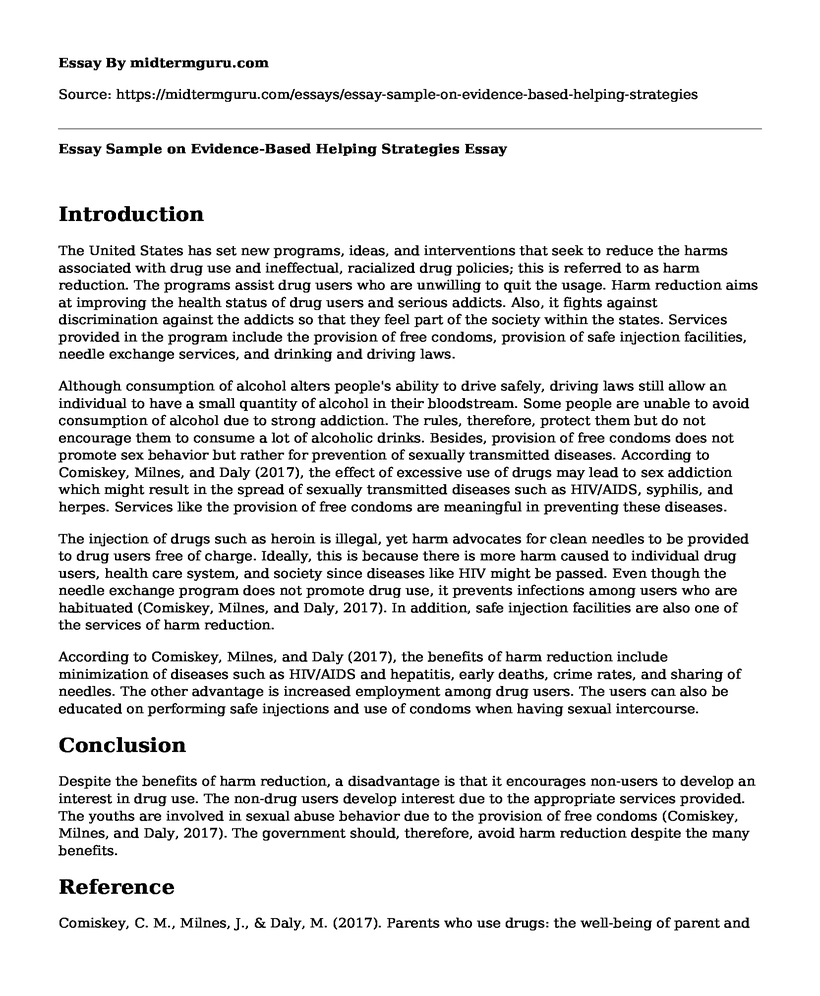Introduction
The United States has set new programs, ideas, and interventions that seek to reduce the harms associated with drug use and ineffectual, racialized drug policies; this is referred to as harm reduction. The programs assist drug users who are unwilling to quit the usage. Harm reduction aims at improving the health status of drug users and serious addicts. Also, it fights against discrimination against the addicts so that they feel part of the society within the states. Services provided in the program include the provision of free condoms, provision of safe injection facilities, needle exchange services, and drinking and driving laws.
Although consumption of alcohol alters people's ability to drive safely, driving laws still allow an individual to have a small quantity of alcohol in their bloodstream. Some people are unable to avoid consumption of alcohol due to strong addiction. The rules, therefore, protect them but do not encourage them to consume a lot of alcoholic drinks. Besides, provision of free condoms does not promote sex behavior but rather for prevention of sexually transmitted diseases. According to Comiskey, Milnes, and Daly (2017), the effect of excessive use of drugs may lead to sex addiction which might result in the spread of sexually transmitted diseases such as HIV/AIDS, syphilis, and herpes. Services like the provision of free condoms are meaningful in preventing these diseases.
The injection of drugs such as heroin is illegal, yet harm advocates for clean needles to be provided to drug users free of charge. Ideally, this is because there is more harm caused to individual drug users, health care system, and society since diseases like HIV might be passed. Even though the needle exchange program does not promote drug use, it prevents infections among users who are habituated (Comiskey, Milnes, and Daly, 2017). In addition, safe injection facilities are also one of the services of harm reduction.
According to Comiskey, Milnes, and Daly (2017), the benefits of harm reduction include minimization of diseases such as HIV/AIDS and hepatitis, early deaths, crime rates, and sharing of needles. The other advantage is increased employment among drug users. The users can also be educated on performing safe injections and use of condoms when having sexual intercourse.
Conclusion
Despite the benefits of harm reduction, a disadvantage is that it encourages non-users to develop an interest in drug use. The non-drug users develop interest due to the appropriate services provided. The youths are involved in sexual abuse behavior due to the provision of free condoms (Comiskey, Milnes, and Daly, 2017). The government should, therefore, avoid harm reduction despite the many benefits.
Reference
Comiskey, C. M., Milnes, J., & Daly, M. (2017). Parents who use drugs: the well-being of parent and child dyads among people receiving harm reduction interventions for opiate use. Journal of Substance Use, 22(2), 206-210.
Cite this page
Essay Sample on Evidence-Based Helping Strategies. (2022, Sep 28). Retrieved from https://midtermguru.com/essays/essay-sample-on-evidence-based-helping-strategies
If you are the original author of this essay and no longer wish to have it published on the midtermguru.com website, please click below to request its removal:
- Sources of CCRC Clients - Paper Example
- Characterization of a New Epidemic in Montana - Public Health Paper Example
- Essay Sample on Racial Tensions in America
- Exploring Diabetes as a Chronic Disease - Essay Sample
- Women Aged 20-29: Cervical Cancer Screenings - Research Paper
- Pernicious Anemia: Vitamin B12 Deficiency & Intestinal Absorption Issues - Essay Sample
- Alternative Medicine: Exploring Options Beyond Standard Care - Essay Sample







